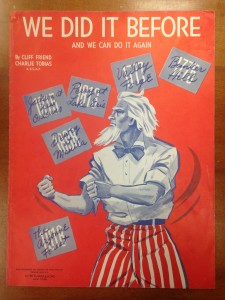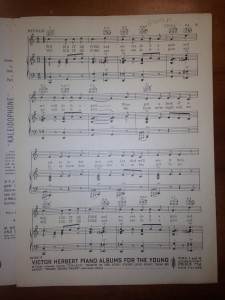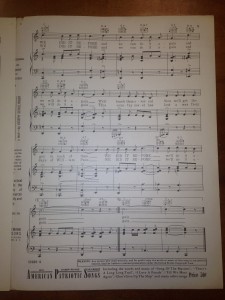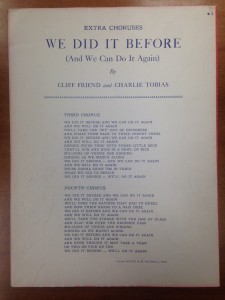Origins
At the start of the Second World War in September of 1939, America was decidedly uninvolved in the conflict. Despite trading and providing supplies to member countries of the Allied forces, the decision to become directly involved in the war effort would come later in December of 1941. After almost 15 months of strained relationships and a year of planning on the offensive side, Japan ordered an airstrike on the American island of Hawaii, at the naval base of Pearl Harbor. This attack shook the nation as citizens were faced with the first foreign attack directly targeting the United States since the First World War. As word of the attack spread and reactions began, “We Did It Before And We Can Do It Again” was penned by popular songwriters Cliff Friend and Charles Tobias. The composition was written the same day as the attack, one of the firsts of its kind during American involvement in the war (Stickles 158). Just days later, the song hit the radio and the ears of America.
Lyrical Content
“We Did It Before And We Can Do It Again” was written as a direct response to the Pearl Harbor attack. Written in a march-like style, the song is upbeat, entertaining, and simple enough for anyone to remember (Bush 125). The lexicon is simple, with minimal syllables per word, and few words per sentence. The repeated chorus, “we did it before and we can do it again” is an announcement that the United States has triumphed in face of adversity before, and if involved, they would once more. A trend throughout the song, numerous threats and warnings are given to dissuade enemies from engaging in combat with the United States. Lyrics like “We’ll knock them over and get the guy in the back” and “We’ll free the nations that had to kneel and bow their heads to a Nazi heel” play on the intimidation tactic of the song, helping to paint the picture of America as the “top dog” in the war effort. The song did not only romanticize the war, but inspired anti-Japanese sentiments in a post-Pearl-Harbor America. Slurs regarded as highly offensive to today’s audience were used in the song like during the claim, “we’ll take the ‘nip’ out of nipponese and chase them back to their cherry trees”. The relationship between Americans and Japanese was riddled with strife, especially after America began to block immigrants from entering the country and stopped all exports of oil to Japan. After Pearl Harbor, the Japanese people were characterized as dangerous, untrustworthy individuals; they were discriminated against and often sent to Japanese internment camps throughout the duration of World War II. In addition to the Japanese, the song strikes out at other opponents with “We’ll put the ax to the Axis quick” and “We’ll take the stooge with the jaw of glass and slap him over the brenner pass”. The Brenner Pass line is a play on words, referring to a mountain pass in Italy, another Axis member along with Germany and Japan. The composers use this language to infantilize and demean the Axis powers. A “jaw of glass”, a jaw easily broken, indicates that the fight, or in this case, the war will be easily won. And if not, the lyrics reassure, “even though it may take a year or two or ten, we did it before – we’ll do it again”. Repeated 16 times through the course of the song, the message is unmistakable: although the opponent will be different, and the war will bear a different name, “We did it before and we can do it again”.
Social Context
The rise of swing and big band music began in the 1920s, and continued all the way through World War II. Several prominent musicians, such as Glenn Miller and Artie Shaw were drafted and brought their music to the warfront. At home, music was often used as an escape or as a source of comfort. These songs tended to embrace hope and optimism. They had simple themes and straightforward titles, a theme that continued in “We Did It Before (And We Can Do It Again)”.
However, the tone and message of these songs changed in the aftermath of Pearl Harbor. After the attack, the publishers in Manhattan’s Tin Pan Alley rushed the production of an astonishing number of songs so that they were printed days or even hours after the news reached the public. “We did it before” was the first of these songs to be played on air, only three days later. Because of its early arrival it quickly became one of the first popular war-themed songs of the second World War in America. Despite the fact that “We Did It Before” is one of many songs revolving around one event, it is much more upbeat and less viciously racist than some of its successors. The attack on Pearl Harbor brought race to the forefront of the public eye in all new ways. While anti-German lyrics mainly focused its ridicule solely on Hitler and the Nazis, anti-Japanese sentiment extended to the civilians as well as the military. The characteristically straightforward 1940s titles made a reappearance with songs like “Let’s Take A Rap at the Japs,” “We’ll Knock The Japs Right Into the Laps of The Nazis,” and “We’re Going To Find A Fellow Who Is Yellow And Beat Him Red White And Blue.” While the final two verses of “We Did It Before (And We Can Do It Again)” also contained racial slurs and stereotyping, the overall intent was to remind the people of this country’s efforts and to act as a unifying force rather than an accusatory one. A song recorded by Kate Smith (also in December of ‘41) serves as a neat parallel to “We did it before.” It’s titled: “They Started Somethin’ (But We’re Going to End It),” foreshadowing the rise in hostilities that would eventually lead to the catastrophic detonation of atomic bombs in Hiroshima and Nagasaki.
The Source: Physical Characteristics

The sheet music cover shows a depiction of Uncle Sam with his arms raised in a fighting pose, underneath the title and authors of the song. The background is solid red, and Uncle Sam is outlined in blue while wearing red and white clothing. In fact, the only colors on the front page are red, white, and blue, the colors of the American flag. This goes along with the patriotic message of the song as a whole, but was likely a practical feature due to the costs and availability of colored inks during the mid- 20th century. Surrounding Uncle Sam are six blue squares with a large date and script-like text. The date and words indicate famous American battles where the United States was a victor. For example, the poster above

Sam’s head reads: “1777, Valley Forge”; a reference to the winter that the continental army spent in valley forge Pennsylvania during the Revolutionary War. During this winter, supplies were so low and conditions were so terrible that literally a quarter of the army died from disease or starvation. However, it was during this time that the troops received the training to become a fighting force strong
enough to defeat the British Army. In short, after a time of extreme hardship, Americans emerged stronger and more unified than ever before. This could be a hopeful allegory for America’s shift from the Great Depression into World War II. The other five notes continue in this fashion, referencing

other moments of American bravery and victory in the Revolutionary War and the War of 1812. Despite these shining examples, it’s worth noting that the time period of the Civil War is completely omitted. The designers of the cover most likely felt that a reminder of a major division between the American people would be unwelcome and counterproductive to creating a feeling of unity.
The music inside the cover is in good condition. The pages are slightly yellowed but there’s no tears or damage to the paper, and the black ink is clearly legible.The only written markings inside are in pencil and for library cataloging purposes. The music itself has parts for voice, guitar, and piano. There are six pages in total, including front and back covers, four of them with the actual sheet music. Two extra

verses are printed on the back page. The margins of each page are filled with text. On the bottom of the first page is copyright information for Witmark & Sons, the publishers. However, the right margin contains advertisement for something called a “kaleidophone,” which continues onto the left margin of page five. The bottom margins of pages three four and five are taken up by advertisements for other song compilations, one of them for children, one of them of ‘popular songs’ and one of them of ‘American Patriotic Songs.’ It is likely that because “We did it before” was such a popular song at the time, it

would be profitable for other businesses to use this as a kind of piggyback to try and sell similar products. This demonstrates how closely tied commercialization and patriotism were at the time of this song’s publication. Businesses were using the war effort to sell their products while keeping civilian morale high. This also represents the ways that propaganda could be easily marketed to the youth. If this could be used to advertise “Victor Herberts Piano Albums For the Youth,” it’s likely that there were several other albums for the youth that advertised songs as patriotic, if not more so, than this one.
Works Cited
Friend, Cliff, Charles Tobias, Albert Lewis, Eddie Cantor, Joe Quillan, Irving Elinson, John Cecil Holm, George Abbott, Hassard Short, and Vernon Duke. 1941. “We did it before : and we can do it again.” n.p.: New York : M. Witmark & Sons, c1941., 1941.
Jones, John Bush. The Songs That Fought the War: Popular Music and the Home Front, 1939-1945. Waltham, MA: Brandeis University Press, 2006.
Sickels, Robert. The 1940s. Westport, CT: Greenwood Press, 2004.
Wells, K. A. “Music as War Propaganda.” Music As Propaganda In World War I. 2004.
Accessed March 06, 2016. http://parlorsongs.com/issues/2004-4/thismonth/feature.php.
“What Happened at Valley Forge.” Ushistory.org. Accessed March 05, 2016.
http://www.ushistory.org/march/phila/valleyforge.htm.
“WWII In American Music: Pearl Harbor & Reaction.” WWII In American Music: Pearl
Harbor & Reaction. July 21, 2012. Accessed March 06, 2016.
http://www.authentichistory.com/1939-1945/3-music/04-PH-Reaction/index.html.
Monica Bello, Lynelle Freeman, Grace Shim